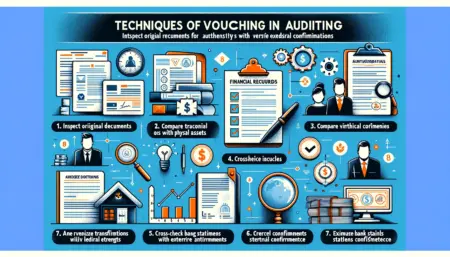Learn about the techniques of vouching in auditing. From document examination to physical verification, explore the various methods used by auditor. Vouching means the checking of truth of items appearing in the books of original entry In other words vouching means an examination of business transactions in the accounting record with documentary evidence
Techniques of Vouching In Auditing: A Comprehensive Guide.

1. ARRANGED VOUCHERS
Auditor should see that whether all the vouchers are properly arranged by the client. If vouchers have not been arranged properly, then auditor should ask to do so.
- CHECKING OF DATE
The auditor should also check the date of voucher with the date in cash book. If there is no date in voucher, then it is not acceptable.
- RELATE TO BUSINESS
The vouchers must contain the name of business. If vouchers contain the name of managers or employees instead of name of business, these are not acceptable.
- CUTTING OR CHANGE
If there is any cutting or change in figures, it must be signed by the authorized person. The auditor should be satisfied about it.
- CORRECT ACCOUNTS
The auditor should also see whether all accounts are correct in all respects. Transactions can be divided in to two accounts by the rules of debit and credit.
- AMOUNTS IN WORDS
All amounts in words and figures must be same The accountant should record the net amount from voucher in entry. The trade discount should not be included in voucher.
- SERIALLY VOUCHERS
All vouchers must be in serial numbered. Because if vouchers are serially numbered then this is a sign of correctness and completeness.
8. Stamp
The Auditor Should see that voucher bears a required revenue stamp or not. The stamps are used according to the value of cash memos.
9. Signature.
The Vouchers must be signed by authorized officers or owners. If Voucher are not signed, these should be recorded in books.
- IMPORTANT NOTES
The auditor should make the note of any item which requires the further information or evidence.
- AGREEMENTS
The auditor should also examine the agreements, correspondence and other relevant papers. Agreements provide the basic information to the auditor.
- UNPRINTED VOUCHERS
Unprinted handmade vouchers are useless. So vouchers must be in printed form. Printed vouchers are true black and white legal evidence.
- LIST OF MISSING AND INCOMPLETE VOUCHERS
Auditor should check the list of missing or incomplete vouchers. This list would be helpful in finding root of errors and fraud in cash book or in other books of accounts.
- PAYMENT
Voucher should also describe whether payment is for complete transaction of sale, purchases etc. Payments may be in different ways such as partially or full.
- USE OF TICKS
Due to routine checking in nature, vouching process is carried out by ticking all the entries, which have already been vouched with evidences. Ticking ensures that what part of work has finished.
In conclusion, vouching plays a crucial role in auditing by substantiating the reliability and accuracy of financial information presented in the statements.
